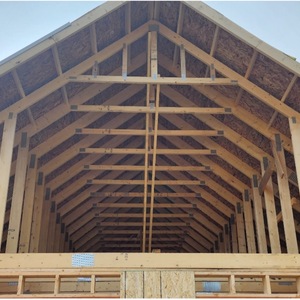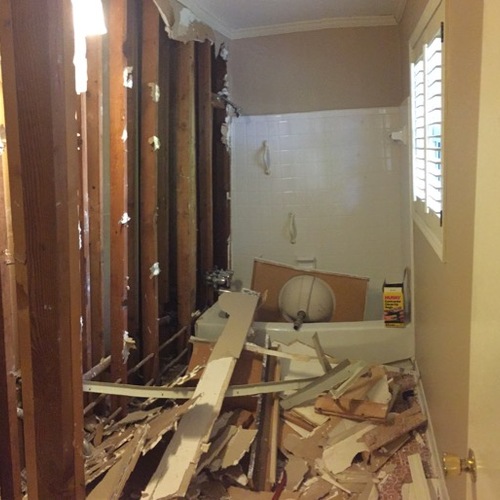
Mike’s long-standing dream had been to build a Passive House in upstate New York, but in the end he bought a brand-new home. Now he’s beginning to wonder whether it has some hidden problems.
“It is supposed to be well insulated, although not anywhere close to Passive House levels,” Mike writes in this recent Q&A post. “I have noticed some uneven snow melt on the roof and it has me concerned something is not right with the insulation details, or the HVAC system.”
He enclosed a photo (above) showing one side of the roof covered uniformly in a thin layer of snow while dark streaks of roofing appear through the snow on the other side.
“In my opinion on a roof that is facing the same direction, with no difference in shading, or slope changes the snow melt should be pretty much uniform if the insulation levels are the same,” Mike continues. “What are your thoughts? Do you think there is a problem here?”
That’s where we start this Q&A Spotlight.
Inside, more clues
Under-insulated, poorly air-sealed cathedral ceilings are problems that have popped up many times in posts at GBA, but in this case the roof on the right side of the house covers a vaulted ceiling with recessed LED lighting and shows no signs of snow melt. On the left is a staircase that goes up to the master suite.
“From my understanding there is spray foam, cellulose, and rigid foam used in this house, but I can’t tell you for sure when it transitions from one to the other,” Mike says. “I am assuming mostly cellulose in the attic areas, spray foam in the walls.”
Weekly Newsletter
Get building science and energy efficiency advice, plus special offers, in your inbox.

This article is only available to GBA Prime Members
Sign up for a free trial and get instant access to this article as well as GBA’s complete library of premium articles and construction details.
Start Free TrialAlready a member? Log in















10 Comments
Well done to Peter for ferreting out the problem.
It makes me think relying on spray foam as both an insulation and air-barrier might not consistently yield the resilience we want in building assemblies.
It also makes me wonder there the building inspections were on that job? No way it should get past a diligent municipal inspector. It sure wouldn't have been passed here.
We used spray foam judiciously in our energy retrofit of our 1890's house in NJ. We primarily used it in the band joist, gable ends, and other complicated areas. We followed that up with blower door assisted air sealing, and we found HUGE holes in the spray foam in the soffit areas. The holes were due primarily to the foam installers not getting around all of the corners very well. One of the holes was the size of a baseball and there were about a dozen that were about equivalent to a golfball. There were cracks in the foam, missed seams, separations, skips and just about everything else you hear about. The installer had one of the best reputations in our area. We fixed the issues with canned foam, and spent only about an hour or so in the process. Fortunately, I have my own blower door and did not have to hire someone.
As they say, "trust, but verify." Spray foam is a great tool for insulation and air sealing, but nothing beats blower door testing before the drywall goes on.
Great sleuthing. Several questions. Any idea what foam product(s) we are looking at? Coloration seems different in the various pics. The large crack ... estimated depth at location of the crack, crack caused by substrate flexing, crack caused by foam shrinkage, bad mix, poor temperature control at application time? Cheers
I believe it is supposed to be all closed cell spray foam, I am not sure what brand or manufacturer. When I was talking to Peter he did note that the colors were different indicating maybe a different day of completion, as well as what looked like maybe open cell in one of the pictures.
With the large crack I am not sure of the depth. That crack goes straight out into the porch roof, when I installed my porch swing I had to cut into insulation way down on the other side of the house to set a couple 2x6 on the load bearing structure. On that side of the house it was a layer of cardboard, followed by 4 inches of rigid polyiso foam, followed by cellulose I think. Now this other side of the house may be a different combination altogether, and maybe the spray foam was just used as a final air sealing layer.
Thank you Peter Yost, Scott Gibson, and everyone who helped troubleshoot the problem!
To give an update, the insulation company who originally did the work came back at the end of last week to get into that knee wall cavity and fix their work. I believe they chiseled out some of the areas where the insulation was separating from the rafters in the sloped ceiling and then slowly re-applied spray foam until the bays were full. They also added additional spray foam over most of the other areas in that knee wall. They did all of their work from within that knee wall pocket, entering from the hole I had already cut.
The next morning after the work we had a pretty good frost, and I got some pictures showing some major improvement. The picture also showed an area of concern, but I believe this is due to some really bad framing choices, and isn't easily fixable without adding continuous insulation. There is a group of three rafters all sistered together which I think is creating one giant thermal bridge, with some minor air leakage going up between them. You can see this in the photos I am attaching.
If I wanted to try to air seal these three combined rafters would you recommend a can of spray foam filler, or should I try to put tape along the length of the rafters?
Thank you,
Mike
Great to see that progress. I'd use some high quality tape to seal that. For example 3m 8067 flashing tape might be easy to find locally.
Thank you!
Great article. To me this is the best type of content. Actual photos of the type of house that most people live in with a practical approach to diagnosing and solving problems.
Thanks all around, but especially to Mike CNY--a real GBA trooper.
In terms of spray foam voids and other defects: I wrote a blog some time ago teaming up with longtime leading spray foam expert, Henri Fennell. The tips in the article cover pretty much all of the quality assurance/quality control steps spray foam contractors should take:
https://www.buildinggreen.com/blog/foam-place-insulation-7-tips-getting-injection-and-spray-foam-right
Are there any comments on success of the CCSF “picture-frame” install-technique to limit low fill & separation at framing/field?
Log in or become a member to post a comment.
Sign up Log in